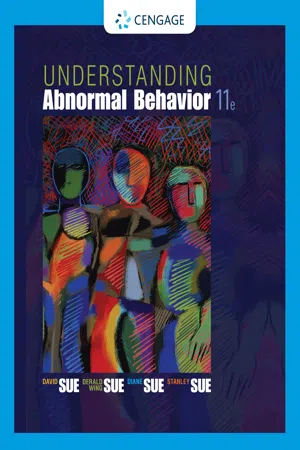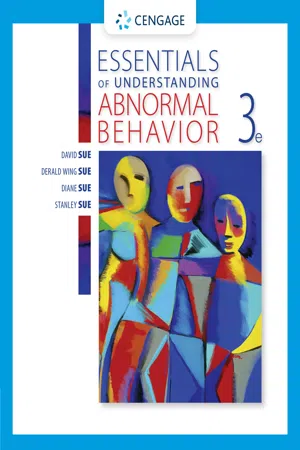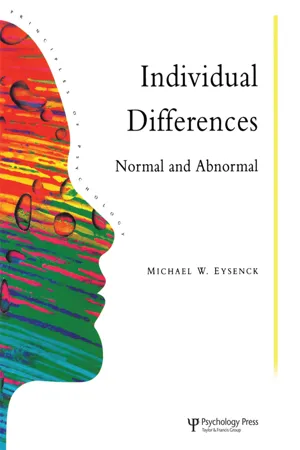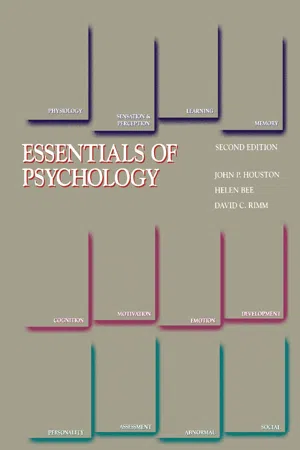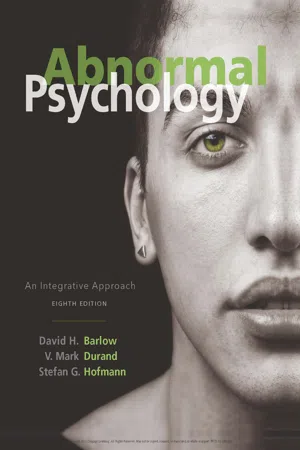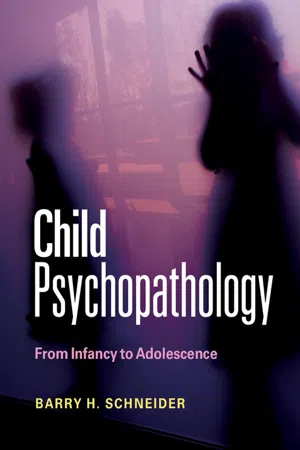Psychology
Abnormal Behavior
Abnormal behavior refers to patterns of thoughts, feelings, or actions that deviate from societal or cultural norms and cause distress or impairment. It is often characterized by behaviors that are atypical, maladaptive, or dysfunctional. Psychologists study abnormal behavior to understand its causes and develop effective treatments for mental health disorders.
Written by Perlego with AI-assistance
Related key terms
1 of 5
10 Key excerpts on "Abnormal Behavior"
- No longer available |Learn more
- David Sue, Derald Wing Sue, Stanley Sue, Diane Sue, David Sue, Derald Wing Sue, Diane Sue, Stanley Sue(Authors)
- 2020(Publication Date)
- Cengage Learning EMEA(Publisher)
Abnormal Behaviors are those that occur least frequently. Thus, Abnormal Behaviors deviate—or represent a significant deviation from— social norms. Some examples of unusual behavior include false perceptions of reality (such as hallucinations ), an intense preoc-cupation with repetitively washing one’s hands, or demonstrating extreme panic in a social setting. Defining symptoms of mental illness can be extremely subjective; decisions about what is normal or abnormal are influenced by the background of the mental health professional evalu-ating the symptoms and the cultural context in which the behavior or symptoms occurs. Certain sexual acts, criminal activities, and homicide are also behaviors that our society considers deviant. However, such activities do not necessarily involve the psy-chological or biological dysfunction associated with mental disorders. Additionally, social norms are far from static, and behavioral standards are not always absolute. Changes in societal attitudes toward human sexuality are a prime example. Many films and magazines now openly exhibit the naked human body and explicit sex acts, and topless and bottomless nightclub entertainment is hardly newsworthy. Additionally, compared to earlier generations, women are freer to question traditional gender roles and to act more assertively in initiating sex. Such changes in attitudes make it difficult to subscribe to absolute standards of normality. However, certain behaviors are considered abnormal in most situations. - David Sue, Derald Wing Sue, Diane Sue, Stanley Sue(Authors)
- 2016(Publication Date)
- Cengage Learning EMEA(Publisher)
However, 19 months after the shooting, his mental condition improved enough for him to participate in court proceedings. He Focus Questions 1. What is abnormal psychology? 2. What are mental disorders and how common are they? 3. What societal factors affect definitions of abnormality? 4. Why is it important to confront the stigmatization associated with mental illness? 5. How have explanations of Abnormal Behavior changed over time? 6. What were early explanations regarding the causes of mental disorders? 7. What are some contemporary trends in abnormal psychology? Copyright 2017 Cengage Learning. All Rights Reserved. May not be copied, scanned, or duplicated, in whole or in part. Due to electronic rights, some third party content may be suppressed from the eBook and/or eChapter(s). Editorial review has deemed that any suppressed content does not materially affect the overall learning experience. Cengage Learning reserves the right to remove additional content at any time if subsequent rights restrictions require it. 2 CHAPTER 1 Abnormal Behavior Abnormal psychology focuses on psychopathology , the study of the symptoms and causes of mental distress and the various treatments for behavioral and mental disorders. Those who study psychopathology attempt to describe, explain, pre-dict, and modify the behaviors, emotions, or thoughts associated with various mental conditions. This includes behavior that ranges from highly unusual to fairly common—from the violent homicides, suicides, and mental breakdowns that are widely reported by the news media to unsensational (but more prevalent) concerns such as depression, anxiety, eating disturbances, and substance abuse. People who work in the field of psychopathology strive to alleviate the distress and life disruption experienced by those with mental disorders and the concerns of their friends and family members.- eBook - PDF
- Nancy Ogden, Michael Boyes, Evelyn Field, Ronald Comer, Elizabeth Gould(Authors)
- 2021(Publication Date)
- Wiley(Publisher)
Judgments of deviance and abnormality vary from society to society. A society that values competition and domi- nance may embrace aggressive behaviour, whereas one that emphasizes cooperation may consider such behaviour unacceptable and even abnormal (Eller, 2016). More- over, a society’s values may change over time, leading to a new societal view of what is psychologically abnormal. In Western society, for example, a woman’s participation in athletics, academia, or business was considered unusual and even inappropriate 100 years ago (Matsumoto & Juang, 2016). Today, people in Western cultures value that behaviour. • Distress To be considered abnormal, behaviours, ideas, or emotions usually must also cause distress or unhappiness (Matthews, 2016). For example, Diane Markos from the opening case feels upset and burdened most of the time by her negative feelings and thoughts and the impact they are having on her life. • Dysfunction Abnormal behaviour also tends to interfere with daily functioning, as opposed to behaviour that is simply eccentric but a part of a person’s life. When behaviour upsets people so that they cannot take proper care of themselves, interact well with others, or work effectively, then it is referred to as abnormal. For example, Diane’s behaviours have contributed to social isolation, problems at work, and conflicts at school. • Danger Some people with psychological dysfunction are more likely to become dangerous to themselves but are less likely to harm others. If, for example, individuals are consistently hostile or confused, they may put themselves, family members, or friends at risk. Recall that Diane Markos’s thoughts of overdosing on pills led her therapist to consider her a serious suicide risk. It is important to note that while the incidence of violence among the mentally ill is slightly higher than in the general population, it is often linked more directly to associ- ated issues of substance abuse (Van Dorn et al., 2017). - eBook - PDF
Essentials of Psychology
Concepts and Applications
- Jeffrey Nevid(Author)
- 2021(Publication Date)
- Cengage Learning EMEA(Publisher)
MODULE 13.1 495 4. Maladaptive behavior. Behavior is maladaptive when it causes personal distress, is self-defeating, or is associated with significant health, social, or occupational problems. For example, abuse of alcohol or other drugs may threaten an individual’s health and ability to function in meeting life’s responsibilities. 5. Dangerousness. Violent or dangerous behavior is another criterion for which we need to examine the social context. For example, engaging in behavior that is dangerous to oneself or others may be an act of bravery in times of war, but not in peacetime. Hockey players and football players regularly engage in physically aggressive behavior that may be dangerous to them- selves or their opponents, but their behavior in athletic competitions is often rewarded with lucrative contracts and endorsement deals. Apart from the sanctioned contexts of warfare and sports, however, violent behavior is likely to be considered abnormal. 6. Faulty perceptions or interpretations of reality. Hallucinations (“hearing voices” or seeing things that are not there) involve distorted perceptions of reality. Similarly, fixed but unfounded beliefs, called delusions, such as believ- ing that FBI agents are listening in on your phone conversations, represent faulty interpretations of reality (unless of course the FBI really is tapping your phone). As we shall see next, the cultural context in which behavior occurs must also be evaluated when making judgments about whether behavior is abnormal. Cultural Bases of Abnormal Behavior Psychologists take the cultural context into account when making judgments about Abnormal Behavior. They realize that the same behavior can be normal in one culture but abnormal in another. For example, in the majority American culture, “hearing voices” is deemed abnormal. Yet among some Native American peo- ples, it is considered normal for individuals to hear the voices of their recently deceased relatives. - eBook - ePub
Individual Differences
Normal And Abnormal
- Michael W. Eysenck, University of London College, College, University of London(Authors)
- 2014(Publication Date)
- Psychology Press(Publisher)
5 Approaches to abnormalityThe remainder of this book is devoted to that part of psychology which is concerned with psychological disorders. This area of psychology is often called abnormal psychology or psychopathology. In order to set the scene for our subsequent coverage of specific forms of psychopathology, we will focus in this chapter on some of the key general issues that confront anyone interested in this area. More specifically, there are three questions that will occupy us in this chapter:1. What do we mean by abnormality, and how can it be distinguished from normality? 2. What are the main categories of psychological disorder? 3. What are the factors responsible for the development of each mental disorder?The first question is obviously important, because we need to know as precisely as possible which patterns of behaviour fall, and do not fall, within the bounds of abnormal psychology. As we will see, it is surprisingly difficult to produce any clear-cut answer to the question, but a partial answer is proposed. The second and third questions refer to the description and the explanation of mental disorders. As with the first question, there are no definitive answers available. What we will do is to present the major current views, and to identify the advantages and disadvantages of each.What is abnormality?There are several different ways in which one might attempt to define “abnormality”. One way is based on the statistical approach, according to which the abnormal is that which is statistically rare in the population. Consider, for example, trait anxiety as assessed by Spielberger’s State-Trait Anxiety Inventory. The mean score for trait anxiety is approximately 40, and only about one person in 50 obtains a score higher than 55. Thus, people who score 55 or more can be regarded as abnormal in the sense that their scores deviate from those of the great majority of the population. - eBook - ePub
- Peter Spurgeon, Roy Davies, Antony Chapman(Authors)
- 2015(Publication Date)
- Routledge(Publisher)
Many extreme behaviours are so appalling they seem impossible to comprehend. In recent years, cases such as the random massacre of fifteen people in Hungerford by gunman Michael Ryan, Dennis Nilsen’s horrific murder and mutilation of fifteen young men and the dismemberment and cannibalism of seventeen victims by the American serial killer Jeffrey Dahmer appear to defy explanation. Psychopathology is concerned with abnormal behaviour but mapping the extent of its domain is particularly difficult because of the variability of human behaviour (both “normal” and “abnormal”) and the numerous shortcomings in current theoretical perspectives. Consequently, human behaviour is often viewed as a spectrum – from “normality” at one end to extreme deviation at the other. The boundary between normal and abnormal behaviour is vague and ill-defined and to complicate matters further it may be that even extremely deviant or bizarre forms of behaviour have counterparts in so-called “normality” (an issue recently discussed by Herschel Prins; (1990).Over the years various criteria for determining abnormality have been proposed and these typically fall into three “camps”; the statistical, the cultural, and those to do with personal distress. Behaviour may be deemed to be abnormal because it is infrequent, rarely observed or deviates from a statistically–defined norm. This normative approach assumes that psychological characteristics are known and can be reliably and validly measured. For instance, mental handicap is usually viewed from the statistical perspective with the lowest 2% (equivalent to an IQ below about 70–75) generally deemed to be mentally handicapped. Such statistical criteria are usually applied in a lop-sided fashion and instances of positive deviance are not included into the definition of abnormality. It is clear that the exceptionally intelligent (those with IQs above 130) are as statistically abnormal as the mentally handicapped but are generally not labelled or treated as deviants.In contrast to statistical criteria, culturally-based criteria of abnormality may be adopted. Here behaviour is judged to be normal or abnormal based upon society’s standards. Unfortunately, society’s standards may not be stable; different cultures have different standards and even within the same culture, what is considered acceptable behaviour may change considerably over time. For example, until recently in Britain, homosexuality was generally condemned, prohibited by law and seen as a form of psychopathology. Since the Sexual Offences Act in 1967, male homosexuality is no longer considered a crime if both partners are over 21, consenting and the behaviour takes place in private. However, defining normality with respect to sexual preferences remains a contentious issue and many mental health professionals still consider that homosexuals experience a great deal of psychodynamic conflict which requires resolution if maturity is to be reached. Others consider that many homosexuals are not necessarily in psychological distress and should be considered as “normal” as the heterosexual population. - eBook - PDF
- John P. Houston, Helen Bee, David C. Rimm(Authors)
- 2013(Publication Date)
- Academic Press(Publisher)
Eventually, hopelessly behind his peers, he drops out of school, only to face new frustrations because most employ-ers will not hire a semiliterate dropout. This further alienates him from society and may spur him to criminal acts, which may lead to jail terms and even further alienation. Thus, a pattern of antisocial behavior is set in childhood and reinforced for the remainder of his life. In this chapter, we have considered several ways of looking at psycho-logical disorders, and we have explored the principal diagnostic categories and subcategories. But clinical psychologists, psychiatrists, and psychiatric social workers do more than theorize about the nature of abnormality and attach labels to people. They also provide treatment for people with psy-chological problems, which is what the next chapter is all about. SUMMARY 1. When other people consider a person's behavior de-viant and threatening, they are likely to label the per-son as abnormal. This is the social-labeling view of abnormality. But people may also label themselves as abnormal. 2. Psychodynamic approaches to Abnormal Behavior stress the importance of unconscious motivation stem-ming from repressed emotional conflicts. 3. Behavioristic approaches to abnormality emphasize that Abnormal Behaviors are learned the same way nor-mal behaviors are learned. Classical and opérant condi-tioning and imitation learning are stressed. Cognitive-behavior therapists also place great emphasis on the role of conscious thinking. 4· Existential-humanistic approaches view the thwart-ing of the self-actualizing tendency as leading to ab-normality. 5. Biological-medical approaches to abnormality stress biological determinants, including inherited or genetic predispositions and biochemical imbalances. Summary 419 6. The broad category of anxiety disorders includes anxiety states, phobias, and obsessive-compulsive dis-orders. - eBook - PDF
Abnormal Psychology
An Integrative Approach
- David Barlow, V. Durand, Stefan Hofmann, , David Barlow, V. Durand, Stefan Hofmann(Authors)
- 2017(Publication Date)
- Cengage Learning EMEA(Publisher)
We now survey many early attempts to describe and treat Abnormal Behavior and to comprehend its causes, which will give you a better perspective on current approaches. In Chapter 2, we examine exciting contemporary views of causation and treatment. In Chapter 3, we discuss efforts to describe, or classify, Abnormal Behavior. In Chapter 4, we review research methods—our systematic efforts to discover the truths underlying description, cause, and treatment that allow us to function as scientist-practitioners. In Chapters 5 through 15, we examine specific disorders; our discussion is organized in each case in the now familiar triad of description, cause, and treatment. Finally, in Chapter 16 we examine legal, professional, and ethical issues relevant to psychological dis-orders and their treatment today. With that overview in mind, let us turn to the past. Historical Conceptions of Abnormal Behavior For thousands of years, humans have tried to explain and con-trol problematic behavior. But our efforts always derive from the theories or models of behavior popular at the time. The purpose of these models is to explain why someone is “acting like that.” Three major models that have guided us date back to the beginnings of civilization. Humans have always supposed that agents outside our bodies and environment influence our behavior, think-ing, and emotions. These agents—which might be divini-ties, demons, spirits, or other phenomena such as magnetic fields or the moon or the stars—are the driving forces behind the supernatural model. In addition, since the era of ancient Greece, the mind has often been called the soul or the psyche and considered separate from the body. Although many have thought that the mind can influence the body and, in turn, the body can influence the mind, most philosophers looked for causes of Abnormal Behavior in one or the other. - eBook - ePub
Understanding Abnormal Psychology
Clinical and Biological Perspectives
- Pamilla Ramsden, SAGE Publications Ltd(Authors)
- 2013(Publication Date)
- SAGE Publications Ltd(Publisher)
The first classification system was developed in the nineteenth century by Emil Kraepelin. He developed a comprehensive model of classifications based on his clinical observations and focused his system on distinctive features, or symptoms associated with abnormal behaviour patterns. His classification systems established the groundwork for future systems that are in use today. The diagnostic and statistical manual of mental disorders published by the American Psychiatric Association (DSM) is descriptive, not explanatory, and describes diagnostic features of abnormal behaviours. Utilizing the DSM classification system, the clinician arrives at a diagnosis by matching the individual’s behaviour with the criteria that define particular patterns of abnormal behaviour. Abnormal patterns of behaviours are classified as mental disorders and involve emotional distress, impaired functioning or behaviour that places people at risk of personal suffering, pain, disability or death. The DSM system helps to sort out various categories of disorders, to identify the disorder most suitable to describe the condition of the individual (Reigier, Narrow & Kupfler, 2010).Table 1.3Purpose of diagnosis1 To organize clinical information that is concise, coherent and retrievable 2 Communication among professions 3 Prediction of clinical course 4 Selection of appropriate treatment Statistical definition of abnormal behaviour
A statistical definition of abnormal behaviour is based upon the concept of the relative frequency of behaviours in a population. Abnormality could be defined as those behaviours that are relatively infrequent or are atypical of the population. A statistical definition would provide a definition based on behaviours that are numerically rare. Utilizing a statistical definition of abnormality we can classify most behaviours within a distribution. The majority of the ‘normal’ population would fall into the middle ranges of a bell-shaped curve. As one moves away from the middle range in either direction they could be classified as being statistically more extreme and therefore abnormal (Helzer & Hudziak, 2002). There are several problems with defining abnormality in this way. If we go back to our previous example of binge drinking, just because more people are engaging in a behaviour that might be dangerous or dysfunctional does not make it normal. However, under this definition, the behaviour would be classified as normal because a large number of individuals participate, therefore individuals in the specified age ranges who do not binge drink would be classified as abnormal. - eBook - PDF
Child Psychopathology
From Infancy to Adolescence
- Barry H. Schneider(Author)
- 2014(Publication Date)
- Cambridge University Press(Publisher)
Development can be considered abnormal, atypical or dysfunctional if it fails to achieve its purpose, which is to bring about adaptation to the environment and maturity (Cicchetti, 2006 ). The field of developmental psychopathology is based on the centrality of developmental processes in the conceptualization of mental illness and mental health. One of its core assumptions is that much can be learned about normal functioning by studying abnormal functioning and that, vice versa, studying abnormal developmental patterns can help elucidate the nature Discarding the notion of atypical or abnormal in the strict statistical sense in favor of a definition based on what society defines as abnormal does not constitute much of an improvement because many cultures may regard some behaviors or traits as deviant for reasons that are arbitrary or even wrong from a moral standpoint. Even though the behaviors need not interfere with either the lives of the individuals who display them or the functioning of society, the sanctions imposed by the culture may create maladjustment for the stigmatized group. Homosexuality is, again, the classic example. Abnormal as maladaptive Mealey ( 2005 ) proposes an evolutionary definition of normality/abnormality in which traits, behaviors or attributes that reduce an individual’s chances of adaptation, survival and reproduction are considered abnormal. He extends this concept to traits, behaviors and attributes that may not necessarily affect the likelihood of survival, adaptation and reproduction of the people who exhibit them but which interfere with the potential of other people to survive, adapt and reproduce. As an example in child psychopathology, he cites conduct disorder, which violates the rights of other children and/or adults even though it may enable the child diagnosed with conduct disorder to achieve some misguided objective of their own.
Index pages curate the most relevant extracts from our library of academic textbooks. They’ve been created using an in-house natural language model (NLM), each adding context and meaning to key research topics.
